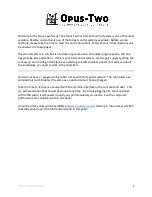
System Characterization
23
9.1.3
Backup DC Voltmeter & DC Ammeter
In an emergency, the Watt's Up can be used like a DC voltmeter or like a DC current
meter. Remember that the Watt's Up can only measure positive voltages and currents.
Connect a battery of at least 4.0 V to the 3-pin auxiliary power connection and to
nothing
else
. The Auxiliary power battery must be "floating electrically."
Use the SOURCE side wires for voltage measurements attaching the Red wire to voltages
that are positive with respect to the Black wire. Only the display's Voltage and Volts
Minimum will be accurate in this application.
To measure DC currents, connect the LOAD side Black wire to where the current comes
from (more positive) and the SOURCE side Black wire to where the current is going to
(less positive). Only the display's Amps and Peak Amps will be accurate in this application.
9.1.4
Calculating Relative Efficiency
The relative efficiency of two models electrical systems can be calculated and compared by
using the Watt's Up in conjunction with a tachometer or other means to measure the
mechanical output of each system. An example procedure for propeller propulsion models
is presented.
To make efficiency measurements, you will need a tachometer or a good quality electronic
fish weight scale. In order to use the tachometer method, you will keep the prop unchanged
while changing other components of the system for comparison. Start by taking a baseline
measurement to compare against. Run the prop up to its typical operating RPM using your
tachometer and make note of the Watts reading on the Watt's Up. Now change the motor,
gearbox, or other system component that you are trying to optimize. Run the prop up to the
same RPM and make note of the Watts reading. The setup that is using the least Watts to
run the prop at the same RPM is the most efficient.
With the fish scale method, you can change any of the system components for comparison.
Mount your fish scale between a stationary object and a rolling sled that the system is
mounted on. Start by taking a baseline measurement to compare against. Run the prop up
to its typical operating and make note of the Watts reading on the Watt's Up and the thrust
reading on the fish scale. Now change the motor, gearbox, or other system component that
you are trying to optimize. Run the prop up until the fish scale reading is the same as
before and make note of the Watts reading. The setup that is using the least Watts to
produce same thrust is the most efficient.
Connect the Watt's Up to each system as described above. Adjust the ESC to the desired
operating point (prop speed from tachometer, etc.) and make note of the Watts reading.
Now connect the Watt's Up to the second system. Adjust the ESC to bring it to the same
operating point. Compare the new Watts reading to the old one to determine the relative
efficiency of the two systems.
"Watt's Up" & "Doc Wattson" Watt Meter and Power Analyzer User's Manual
RC Electronics, Inc.











































